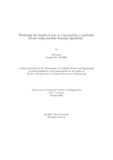| dc.contributor.advisor | Chakrabarty, Amitabha | |
| dc.contributor.author | Imam, Saif | |
| dc.date.accessioned | 2021-12-01T06:21:45Z | |
| dc.date.available | 2021-12-01T06:21:45Z | |
| dc.date.copyright | 2021 | |
| dc.date.issued | 2021-10 | |
| dc.identifier.other | ID 17373001 | |
| dc.identifier.uri | http://hdl.handle.net/10361/15681 | |
| dc.description | This thesis is submitted in partial fulfilment of the requirements for the degree of Master of Engineering in Computer Science and Engineering, 2021. | en_US |
| dc.description | Cataloged from PDF version of thesis. | |
| dc.description | Includes bibliographical references (page 27). | |
| dc.description.abstract | Every single day a large number of patients go to the hospital. But the fact is,
facilities available in hospitals are not su cient in comparison with the number of
patients. The idea of this paper is to o er a prediction system that will be able to
say how many days a patient may stay in a hospital. So that the hospital authority
may be able to make a better plan to support a large number of patients. In this
project, the focus is to give a statistical overview of the recovery time of di erent
diseases in Bangladesh and provide a predictive knowledge based on machine learning
algorithms about the possible treatment duration for those diseases. We are
hopeful that this prediction system will be a great thing for any hospital authority.
They will be able to know the estimated staying duration of a patient in hospital
and based on that they will prepare plans to provide support to a larger number
of patients. In traditional computing, implementing a system like this is quite impossible
because the data here does not follow any algorithmic pattern and that's
the reason behind introducing machine learning for this particular task. We tried to
accumulate all possible treatments and records of patients and run machine learning
algorithms like Linear Regression, Boosted Decision Tree, and Bayesian Regression.
We compared the accuracy, mean absolute error and root mean squared error for
the results we generated from ML Studio using Linear Regression (LR), Bayesian
Regression (BR) and Boosted Decision Tree (BDT) and the results are as follows:
Accuracy: LR=0.79, BDT=0.72, BR=0.71
Mean absolute error: LR=0.21, BDT=0.24, BR=0.27
Root mean squared error: LR=0.32, BDT=0.36, BR=0.37 | en_US |
| dc.description.statementofresponsibility | Saif Imam | |
| dc.format.extent | 27 pages | |
| dc.language.iso | en | en_US |
| dc.publisher | Brac University | en_US |
| dc.rights | Brac University theses are protected by copyright. They may be viewed from this source for any purpose, but reproduction or distribution in any format is prohibited without written permission. | |
| dc.subject | Length of Stay | en_US |
| dc.subject | Linear Regression | en_US |
| dc.subject | Boosted Decision Tree | en_US |
| dc.subject | Bayesian Regression | en_US |
| dc.subject.lcsh | Machine learning | |
| dc.subject.lcsh | Computer algorithms | |
| dc.title | Predicting the length of stay in a hospital for a particular disease using machine learning algorithms | en_US |
| dc.type | Thesis | en_US |
| dc.contributor.department | Department of Computer Science and Engineering, Brac University | |
| dc.description.degree | M. Computer Science and Engineering | |

